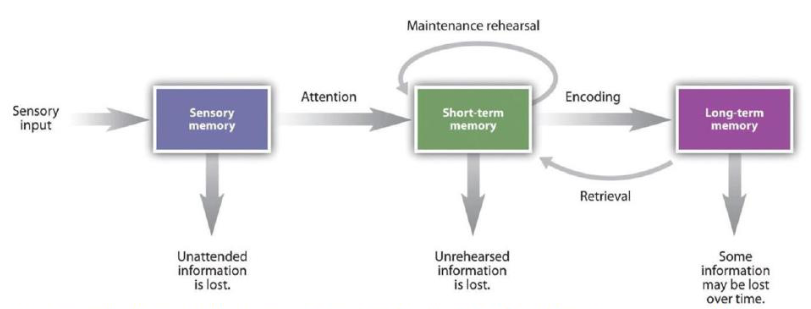54 Memory
Martha Lally; Suzanne Valentine-French; and Dinesh Ramoo
Based on studies of adults, people with amnesia, and neurological research on memory, researchers have proposed several “types” of memory (see Figure 4.12). Sensory memory (also called the sensory register) is the first stage of the memory system, and it stores sensory input in its raw form for a very brief duration; essentially long enough for the brain to register and start processing the information. Studies of auditory sensory memory have found that the sensory memory trace for the characteristics of a tone last about one second in 2 year-olds, two seconds in 3-year-olds, more than two seconds in 4-year-olds, and three to five seconds in 6-year-olds (Glass, Sachse, and vob Suchodoletz, 2008). Other researchers have found that young children hold sounds for a shorter duration than older children and adults. This deficit is not due to attentional differences between these age groups, but reflects differences in the performance of the sensory memory system (Gomes et al., 1999).
The second stage of the memory system is called short-term memory or working memory. Working memory is the component of memory in which current conscious mental activity occurs. Working memory often requires conscious effort and adequate use of attention to function effectively. As you read earlier, children in this age group struggle with many aspects of attention and this greatly diminishes their ability to consciously juggle several pieces of information in memory. The capacity of working memory, that is the amount of information someone can hold in consciousness, is smaller in young children than in older children and adults. The typical adult and teenager can hold a seven-digit number active in their short-term memory. The typical 5-year-old can hold only a four-digit number active. This means that the more complex a mental task is, the less efficient a younger child will be in paying attention to, and actively processing, information in order to complete the task.
Changes in attention and the working memory system also involve changes in executive function. Executive function refers to self-regulatory processes, such as the ability to inhibit a behaviour or cognitive flexibility, that enable adaptive responses to new situations or to reach a specific goal. Executive function skills gradually emerge during early childhood and continue to develop throughout childhood and adolescence. Like many cognitive changes, brain maturation, especially the prefrontal cortex, and experience influence the development of executive function skills. A child whose parents are more warm and responsive, use scaffolding when the child is trying to solve a problem, and who provide cognitively stimulating environments for the child show higher executive function skills (Fay-Stammbach, Hawes, and Meredith, 2014). For instance, scaffolding was positively correlated with greater cognitive flexibility at age two and inhibitory control at age four (Bibok, Carpendale, and Müller, 2009).

Older children and adults use mental strategies to aid their memory performance. For instance, simple rote rehearsal may be used to commit information to memory. Young children often do not rehearse unless reminded to do so, and when they do rehearse, they often fail to use clustering rehearsal. In clustering rehearsal, the person rehearses previous material while adding in additional information. If a list of words is read out loud to you, you are likely to rehearse each word as you hear it along with any previous words you were given. Young children will repeat each word they hear, but often fail to repeat the prior words in the list. In Schneider, Kron-Sperl, and Hunnerkopf’s (2009) longitudinal study of 102 kindergarten children, the majority of children used no strategy to remember information, a finding that was consistent with previous research. As a result, their memory performance was poor when compared to their abilities as they aged and started to use more effective memory strategies.

The third component in memory is long-term memory, which is also known as permanent memory. A basic division of long-term memory is between declarative and non-declarative memory. Declarative memories, sometimes referred to as explicit memories, are memories for facts or events that we can consciously recollect. Non-declarative memories, sometimes referred to as implicit memories, are typically automated skills that do not require conscious recollection. Remembering that you have an exam next week would be an example of a declarative memory. In contrast, knowing how to walk so you can get to the classroom or how to hold a pencil to write would be examples of non-declarative memories. Declarative memory is further divided into semantic and episodic memory. Semantic memories are memories for facts and knowledge that are not tied to a timeline, while episodic memories are tied to specific events in time.
A component of episodic memory is autobiographical memory, or our personal narrative. As you may recall in chapter three, the concept of infantile amnesia was introduced. Adults rarely remember events from the first few years of life. In other words, we lack autobiographical memories from our experiences as an infant, toddler, and very young preschooler. Several factors contribute to the emergence of autobiographical memory, including brain maturation, improvements in language, opportunities to talk about experiences with parents and others, the development of theory of mind, and a representation of “self” (Nelson and Fivush, 2004). Two-year-olds do remember fragments of personal experiences, but these are rarely coherent accounts of past events (Nelson and Ross, 1980). Children between the ages of two and two-and-a-half can provide more information about past experiences. However, these recollections require considerable prodding by adults (Nelson and Fivush, 2004). Over the next few years children will form more detailed autobiographical memories and engage in more reflection of the past.
Media Attributions
- Figure 4.13: How long will these children remember their trip to Disneyland? © Jae Park is licensed under a Public Domain license

